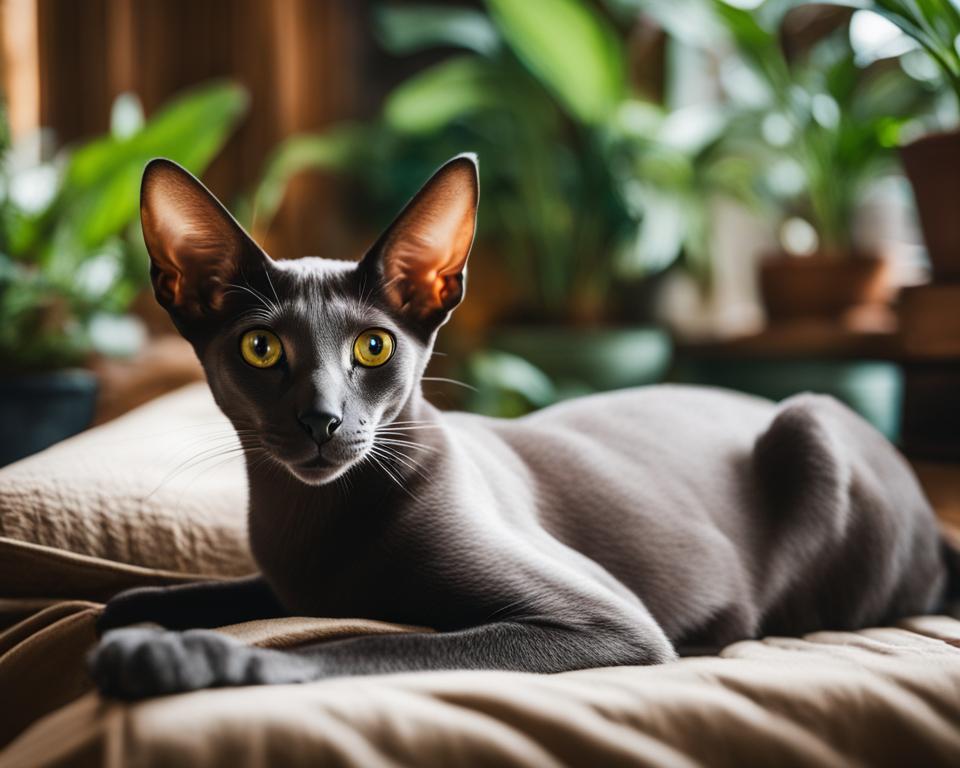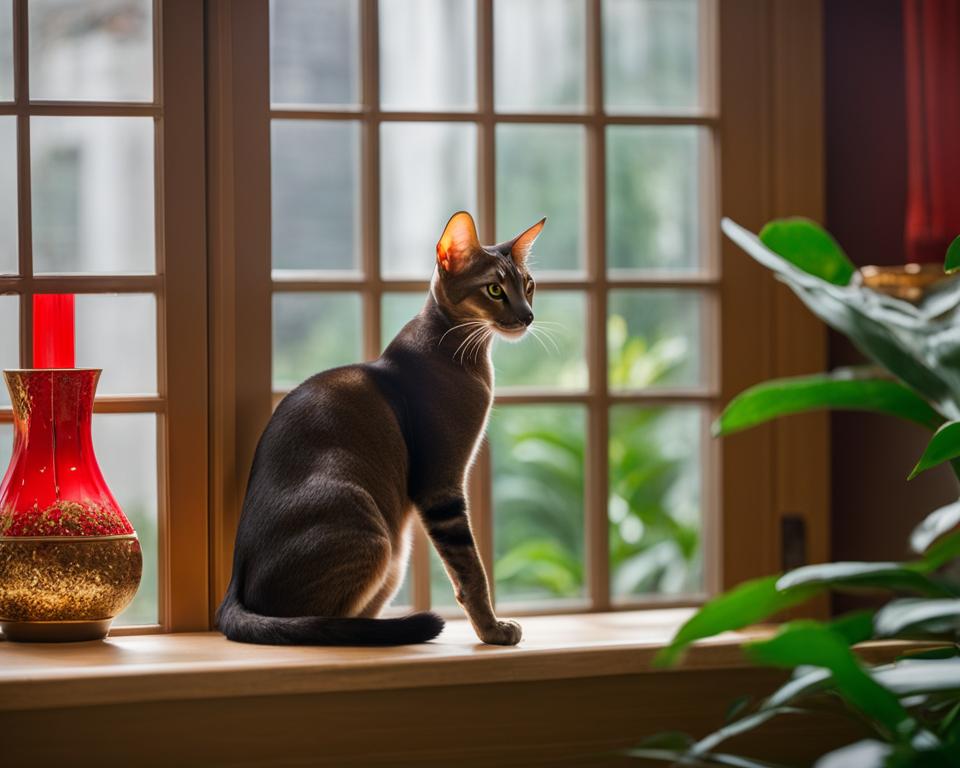Oriental shorthairs are affectionate, sociable cats known for their friendly personality. They have a sleek coat that is easy to groom and enjoy a longer lifespan compared to other breeds. They are medium-sized cats, but their long, slender frame gives them a taller presence. Oriental shorthairs come in a wide range of colors and patterns. They are highly intelligent and require constant stimulation and playtime. These cats thrive in both homes and apartments, but it is important to provide them with a cat-friendly environment and enough playtime to prevent boredom.
Key Takeaways:
- Creating a cat-friendly home for Oriental Shorthairs is essential for their well-being and happiness.
- Provide plenty of vertical space for climbing and exploration, such as shelves, bridges, and cat trees.
- Offer interactive toys and scratching posts to keep them mentally and physically stimulated.
- Regular grooming, including brushing and ear cleaning, is important for their coat and overall health.
- Be aware of potential health issues that Oriental Shorthairs may be prone to and schedule regular vet check-ups.
Understanding the Temperament and Behavior of Oriental Shorthairs
Oriental shorthairs are intelligent and affectionate cats that thrive on companionship and interaction. Their friendly nature and sociable personality make them an excellent choice for families and individuals alike. These cats are often referred to as “Velcro kitties” because of their tendency to stick close to their owners, following them from room to room. They enjoy being part of the action and will often seek out human company.
In terms of energy levels, Oriental shorthairs fall somewhere in the middle. They love to play, but they also enjoy their downtime and snuggling with their loved ones. To prevent boredom, it is essential to provide them with plenty of mental and physical stimulation. Interactive toys that appeal to their natural hunting instincts are highly recommended. Engage them in regular play sessions that allow them to chase, jump, and exercise. This will not only keep them physically fit but also mentally stimulated and content.
Talkative and Social
One unique characteristic of Oriental shorthairs is their talkative nature. They have a distinct honk-like cry that they use to communicate with their owners. They enjoy holding conversations and will happily chirp and purr to express their happiness or seek attention. Their vocal nature makes them excellent companions for those who enjoy interactive and engaging conversations with their pets.
When it comes to their behavior with other pets and children, Oriental shorthairs generally get along well. They are friendly and adaptable, making them compatible with dogs and other cats. However, as with any interactions between pets or children, it is essential to supervise and ensure a safe environment for everyone involved.
The Importance of Exercise and Mental Stimulation
To keep Oriental shorthairs happy and healthy, it is crucial to provide them with enough exercise and mental stimulation. These cats are intelligent and require activities that challenge their minds. Puzzle toys, treat dispensers, and interactive games are great ways to engage their intellectual curiosity. Additionally, dedicating time for play sessions and providing climbing structures or cat trees can help satisfy their natural instincts to explore and climb.
By understanding the temperament and behavior of Oriental shorthairs, you can create an environment that caters to their specific needs. Offering them companionship, interactive play, and mental enrichment will ensure they live a fulfilled and contented life as part of your family.
Creating a Cat-Friendly Home for Oriental Shorthairs
Designing a cat-friendly home is essential to ensure that your Oriental Shorthair thrives in a safe and stimulating environment. By providing them with the right tools and spaces, you can enhance their quality of life and overall well-being. Here are some tips to help you create a cat-friendly home for your Oriental Shorthair:
Vertical Space
Oriental Shorthairs love to climb and explore, so it’s important to give them plenty of vertical space. Installing shelves, bridges, and cat trees will satisfy their natural instinct to climb and jump. This not only provides them with exercise but also allows them to observe their surroundings from a higher vantage point.
Cozy Hiding Spots and Elevated Perches
Creating cozy hiding spots and elevated perches near windows can provide your Oriental Shorthair with the perfect spot to relax and observe the outside world. They enjoy having their own private space where they can retreat and feel safe. Consider adding cat beds or cozy blankets in these areas to make them even more inviting.
Interactive Toys and Scratching Posts
Mental and physical stimulation is crucial for Oriental Shorthairs. Providing them with interactive toys, such as puzzle feeders and toys that encourage hunting instincts, will keep them engaged and prevent boredom. Additionally, having scratching posts throughout your home will satisfy their natural urge to scratch and help keep their claws healthy and trim.
Avoiding Hazards
When creating a cat-friendly home, it’s important to identify and secure any potential hazards. Keep toxic plants out of reach and ensure that windows are securely closed or have screens installed to prevent accidents. Providing a safe environment will give you peace of mind knowing that your Oriental Shorthair is protected.
| Benefits of a Cat-Friendly Home for Oriental Shorthairs | Tips for Creating a Cat-Friendly Home |
|---|---|
| 1. Increased physical activity and mental stimulation | 1. Install shelves, bridges, and cat trees for climbing and jumping |
| 2. Reduced stress and anxiety | 2. Create cozy hiding spots and elevated perches near windows |
| 3. Prevention of destructive behavior | 3. Provide interactive toys and scratching posts |
| 4. Improved overall well-being and happiness | 4. Identify and secure potential hazards |
Grooming and Care Tips for Oriental Shorthairs
Oriental shorthairs have a short, sleek coat that is relatively easy to groom. Regular brushing will help maintain the shine of their coat and reduce shedding. Use a soft-bristle brush or a grooming glove to gently remove loose hair and keep their coat looking its best. Brushing also helps to prevent hairballs, a common issue in cats. Aim to brush your Oriental shorthair at least once a week, or more frequently during shedding seasons.
Aside from brushing, it is essential to pay attention to your Oriental shorthair’s ears. These cats are prone to wax buildup, which can lead to ear infections if left untreated. Check their ears regularly for any signs of redness, discharge, or foul odor. Use a vet-approved ear cleaning solution and cotton balls to clean the visible parts of the ears. However, avoid inserting anything into the ear canal to prevent injury.
Trimming your cat’s nails is another crucial aspect of grooming. Invest in a pair of cat nail clippers and gradually introduce your Oriental shorthair to the process. Start by gently handling their paws and rewarding them with treats for positive associations. Once your cat is comfortable, trim the tips of their nails, being careful not to cut too close to the quick. If you’re unsure, consult your veterinarian for guidance.
Regular visits to the vet are vital to ensure your Oriental shorthair stays healthy. Schedule annual check-ups to monitor their overall well-being, update vaccinations, and address any concerns you may have. Additionally, provide your cat with a balanced diet, fresh water, and a clean litter box to maintain their overall health and happiness.
Health Considerations for Oriental Shorthairs
Oriental shorthairs, like any other breed, have certain health considerations that owners should be aware of. While they are generally a healthy breed, there are a few conditions that can affect them. Understanding these health issues and taking proactive measures can help ensure the well-being of your Oriental shorthair.
Oriental shorthairs have an average lifespan of 12 to 15 years, but some may live even longer with proper care. It’s important to monitor their health regularly and schedule routine check-ups with a veterinarian. This allows for early detection of any potential issues and prompt treatment if necessary.
One health concern that Oriental shorthairs can be prone to is Amyloidosis, a condition where abnormal protein deposits form in tissues and organs, leading to organ failure. Regular veterinary check-ups can help monitor for any signs of this condition. Additionally, maintaining a healthy weight through a balanced diet and regular exercise can reduce the risk of developing obesity-related health issues.

Another condition to be aware of is progressive retinal atrophy, a degenerative eye disease that can lead to gradual vision loss. While there is no cure for this condition, regular eye examinations can help monitor its progression. Early intervention and management strategies can improve the quality of life for cats affected by progressive retinal atrophy.
| Health Issue | Description |
|---|---|
| Amyloidosis | A condition where abnormal protein deposits form in tissues and organs, leading to organ failure. |
| Progressive Retinal Atrophy | A degenerative eye disease that can result in gradual vision loss. |
Overall, providing a well-balanced diet, regular exercise, and routine veterinary care are key to maintaining the health and well-being of your Oriental shorthair. By being aware of these potential health issues and taking proactive measures, you can help ensure a long and happy life for your feline companion.
The History and Origins of Oriental Shorthairs
The Oriental Shorthair breed has a fascinating history that traces back to its origins in Britain in the 1950s. Breeders began crossing Siamese cats with other breeds to create a cat with a variety of coat colors and patterns. The first solid colored Siamese cats were excluded from the Siamese breed and given the name “foreign shorthair,” which eventually became the Oriental breed. Over time, Oriental shorthairs produced longhair kittens, leading to the recognition of the Oriental Longhair breed.
In the 1970s, Oriental Shorthairs gained popularity in the United States and have since become a beloved breed among cat enthusiasts. Their unique appearance and affectionate nature have contributed to their popularity. Oriental Shorthairs have a sleek, short coat and a long, slender frame that gives them a distinctive and elegant presence. They come in a wide range of colors and patterns, adding to their visual appeal.
Today, Oriental Shorthairs are recognized for their intelligence, sociability, and playful nature. They form strong bonds with their families and are known to be “Velcro kitties,” always eager to be close to their owners. Their friendly and outgoing temperament makes them a great choice for families with children and other pets. Oriental Shorthairs thrive in an environment that provides them with plenty of mental and physical stimulation, ensuring their happiness and well-being.

| Breed Name | Origin | Coat Type | Temperament |
|---|---|---|---|
| Oriental Shorthair | Britain | Short, sleek coat | Intelligent, sociable, playful |
| Oriental Longhair | Britain | Long, flowing coat | Intelligent, sociable, playful |
The Oriental Shorthair Breed
The Oriental Shorthair is a unique and captivating breed that originated from the desire to create a cat with a variety of coat colors and patterns. With their history rooted in Britain, Oriental Shorthairs have evolved into intelligent, sociable, and playful cats that bring joy to their families. Their sleek and elegant appearance, combined with their affectionate nature, make them a popular choice among cat lovers.
Tips for Creating an Enriching Environment for Oriental Shorthairs
To prevent boredom in your Oriental Shorthair and ensure their overall well-being, it is important to create an enriching environment that caters to their natural instincts and need for mental and physical stimulation.
One way to keep your Oriental Shorthair entertained is by providing interactive toys. Toys that allow them to chase, pounce, and exercise their hunting instincts are particularly beneficial. Consider toys that have feathers, bells, or balls that can be swatted and chased. Additionally, puzzle feeders can make mealtime more engaging, as they require your cat to work for their food.
Regular play sessions are essential for Oriental Shorthairs. Set aside dedicated time each day to engage in interactive play with your cat using their favorite toys. This will not only provide exercise but also strengthen the bond between you and your feline companion.
Creating vertical spaces within your home is another great way to enrich your Oriental Shorthair’s environment. Install cat trees, shelves, or perches that allow them to climb, jump, and explore. This will not only fulfill their natural instinct to be up high but also provide them with a sense of security and territory.
FAQ
How long do Oriental shorthairs live?
Oriental shorthairs typically have a lifespan of 12 to 15 years, but some can live even longer.
What are the common health issues for Oriental shorthairs?
Oriental shorthairs can be susceptible to conditions like Amyloidosis, which can lead to organ failure, and progressive retinal atrophy, a gradual form of vision loss.
What is the history of Oriental shorthairs?
Oriental shorthairs originated in Britain in the 1950s when breeders started crossing Siamese cats with other breeds. They gained popularity in the United States in the 1970s.
How should I create a cat-friendly home for Oriental shorthairs?
To create a cat-friendly home, provide plenty of vertical space for climbing, interactive toys for mental stimulation, and cozy hiding spots or perches near windows.
How should I groom and care for Oriental shorthairs?
Oriental shorthairs have a short, sleek coat that is relatively easy to groom. Regular brushing, ear cleaning, nail trimming, and maintaining a clean litter box are important.
How can I prevent boredom in Oriental shorthairs?
To prevent boredom, provide interactive toys, vertical spaces for climbing, and regular play sessions. Rotate and change their toys regularly to keep their interest.
What is the temperament of Oriental shorthairs?
Oriental shorthairs are affectionate, sociable, intelligent cats that enjoy both playtime and snuggling. They are known to be talkative and friendly.

Leave a Reply